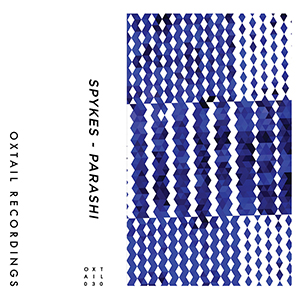Spykes-Parashi
 The four untitled pieces that make up this (similarly untitled) cassette were recorded one November in 2016 as John Olson (Spykes) was in the upstate New York area and looking to collaborate. Thus enters electronics virtuoso Mike Griffin (Parashi, also a member of psych rock collective Burnt Hills), and the two got together in Griffin's suburban basement studio. With Olson in full on psy jazz mode and Griffin manning the pedals, the final product is a combination of two disparate, yet perfectly complementary performers.
The four untitled pieces that make up this (similarly untitled) cassette were recorded one November in 2016 as John Olson (Spykes) was in the upstate New York area and looking to collaborate. Thus enters electronics virtuoso Mike Griffin (Parashi, also a member of psych rock collective Burnt Hills), and the two got together in Griffin's suburban basement studio. With Olson in full on psy jazz mode and Griffin manning the pedals, the final product is a combination of two disparate, yet perfectly complementary performers.
The first of the four performances builds up from a wall of squelchy loops and droning electronics conjured by Parashi.The noise chaotic and at times seemingly random, but clearly under Griffin's control as Olson's reeds rise up like a snake charmer’s cobra.The nasal tones contrast the crunching electronic rumble expertly, pairing the organic with inorganic and the two perfectly complementing each other.
Olson's reeds lead off the second performance as well:a pained caterwaul cutting through the surging, spacious electronics that nearly engulf his playing.With time Griffin introduces some treated tapes and sputtering voices, as Olson works in some unconventional reed noises.Eventually he switches over to saxophone and the mood turns to a jazzier one.While Olson gets down, Griffin's electronics are repurposed into expanding waves of sound and textured with flatulent bursts and ending with sputtering, decaying electronics.
On the other side of the tape, the horns and scraping electronics come out aggressively, like white noise sheets piled atop a buzzing electric generator.Eventually Olson takes a break from actually playing his instrument and instead uses it to make a slew of noises it was not intended for as Griffin keeps the electronics running.Soon the traditional horn sound is back and animal like noises come forth from sped up and mangled cassette tapes.By the end the duo sink into an almost conventional jazz groove, with horns in the lead and electronics taking up the role of the backing band in a pleasantly obtuse way.
The final collaboration is a slower growing one, at first a pairing of smooth horn and dubby, delayed electronics.The two exercise an admirable amount of restraint here, each contributing more subtle sounds and allowing them to expand in the mix, doing quite a bit of work with just a little in the way of actual performance.In its closing moments, however, the sound builds up powerfully.Olson keeps his playing jazzy and traditional, but Griffin works in a multitude of distortion and shrill, Theremin like blasts to end on an appropriately aggressive conclusion.
Listened to in isolation, it would at times seem like Spykes and Parashi are making sounds with drastically different intent from one another: when the former decides to take things smooth, the latter adds another pedal to the textural sonic abyss.Even with all of this contrast, the sound is always fitting and complementary between the two artists.They may have drastically different approaches to this recording, but Griffin and Olson’s performances bounce off each other perfectly, demonstrating both artists’ ability not only as performers, but improvisers in the classical sense.
samples:
 



